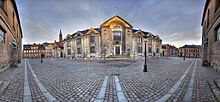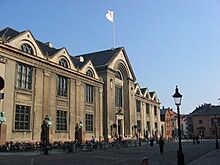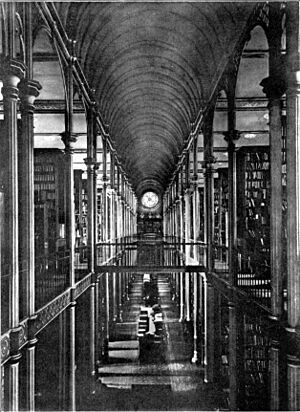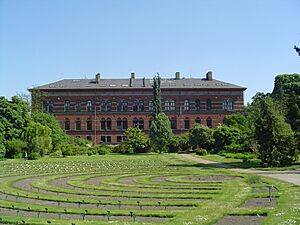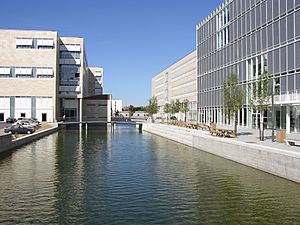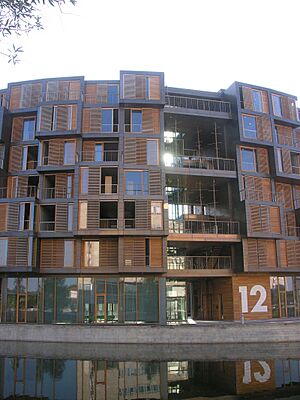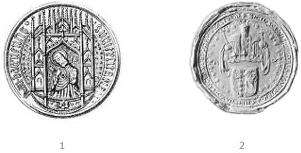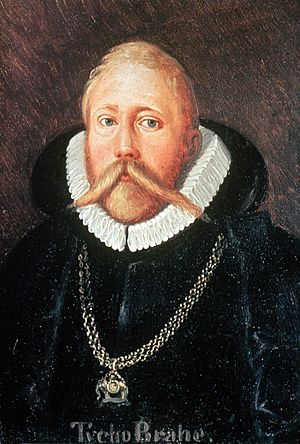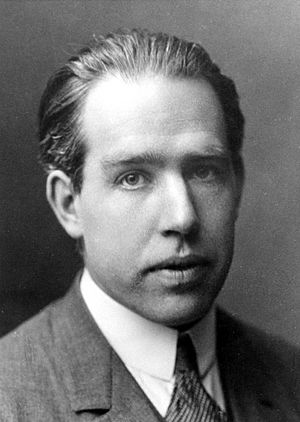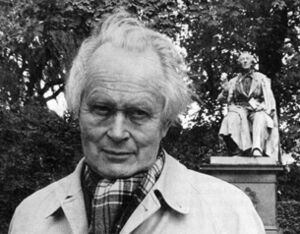University of Copenhagen facts for kids
|
Københavns Universitet
|
|
 |
|
| Latin: Universitas Hauniensis or Hafniensis | |
| Motto | Latin: Coelestem adspicit lucem |
|---|---|
|
Motto in English
|
It (the eagle) beholds the celestial light |
| Type | Public research university |
| Established | 1 June 1479 |
|
Academic affiliation
|
IARU LERU EUA Europaeum Universities Denmark |
| Budget | DKK 8.908 bn ($1.338 bn) (2018) |
| Rector | Henrik C. Wegener |
|
Academic staff
|
5,286 (2019) |
|
Administrative staff
|
4,119 (2017) |
| Students | 37,493 (2019) |
| Undergraduates | 21,394 (2019) |
| Postgraduates | 16,079 (2019) |
| 3,106 (2016) | |
| Location | , |
| Campus | Urban 94.2 ha (total) |
| Student newspaper | Uniavisen |
| Colors | Maroon and gray |
The University of Copenhagen (called Københavns Universitet in Danish, or just KU) is a big public university in Copenhagen, Denmark. It was started in 1479, making it the second-oldest university in Scandinavia, right after Uppsala University.
The University of Copenhagen has six main study areas called faculties. Teaching happens across its four campuses, all located in Copenhagen. The university also runs many departments and research centers. It even has museums and botanical gardens in and around Denmark's capital city. The university also owns research stations in Denmark and two in Greenland. The Faculty of Health and Medical Sciences works closely with public hospitals in the Capital and Zealand Regions of Denmark. Together, they form the Copenhagen University Hospital.
As of October 2022, ten Nobel Prize winners and one Turing Award winner have been connected to the University of Copenhagen. They were either students, graduates, or teachers there. Many famous people have studied here, including a president of the United Nations General Assembly and at least 24 prime ministers of Denmark.
Contents
A Look Back: The University's History
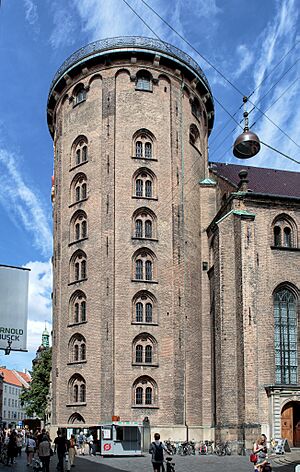
The University of Copenhagen was officially founded on June 1, 1479. This makes it the oldest university in Denmark. In 1475, King Christian I of Denmark received special permission from Pope Sixtus IV to start a university in Denmark. This permission was given after the King's wife, Queen Dorothea of Brandenburg, visited Rome.
On October 4, 1478, King Christian I officially created the University of Copenhagen with a royal order. In this order, he set the rules for the university. He chose Magistar Peder Albertsen to be the vice chancellor. It was Peder's job to hire smart scholars for the new university. This led to the creation of its first four main study areas: theology, law, medicine, and philosophy. From the very beginning, the university had royal support. It was also set up to be independent, meaning it had a lot of freedom and was not controlled by the usual Danish laws.
The university closed down around 1531 because of the spread of Protestantism. However, King Christian III reopened it in 1537 after the Lutheran Reformation. The king asked Johannes Bugenhagen to create a new university plan. This plan was put into action in 1539. Between 1675 and 1788, the university started requiring exams for degrees. Theology exams began in 1675, followed by law in 1736. By 1788, all study areas required an exam to get a degree.
In 1807, many of the university's buildings were badly damaged during the British attack on Copenhagen. But by 1836, a new main building was opened. Many other buildings were also built until the end of that century. During this time, the University Library (now part of the Royal Library), the Zoological Museum, the Geological Museum, the Botanic Garden with greenhouses, and the Technical College were also created.
Between 1842 and 1850, the university's study areas were reorganized. In 1842, the Medical Faculty and the Academy of Surgeons joined to form the Faculty of Medical Science. In 1848, the Faculty of Law changed to become the Faculty of Jurisprudence and Political Science. In 1850, the Faculty of Mathematics and Science became separate from the Faculty of Philosophy. Copenhagen also hosted student meetings with Lund University in 1845 and 1862.
The first female student joined the university in 1877. The university grew very quickly between 1960 and 1980. The number of students jumped from about 6,000 in 1960 to around 26,000 in 1980. The number of staff also grew a lot. New buildings from this time include the Zoological Museum, the Hans Christian Ørsted and August Krogh Institutes, the campus on Amager Island, and the Panum Institute.
In 1970, a new university rule allowed students and staff to have more say in how the university was run. This rule was changed in 1973 and then applied to all higher education places in Denmark. However, this democratic approach was later reversed with university changes in 2003. Further changes from 1990 to 1993 made a Bachelor's degree program required for almost all subjects.
Also in 1993, the law departments separated from the Faculty of Social Sciences to form their own Faculty of Law. In 1994, the University of Copenhagen decided to focus on environmental studies, global relations, and biotechnology as important areas. Starting in 1996, the university planned new buildings, including for the Faculty of Humanities at Amager (Ørestaden) and a Biotechnology Centre. By 1999, there were over 35,000 students, so the university hired more teachers and staff.
In 2003, a new Danish university law changed how decisions were made. It removed students and staff from the main decision-making process. This created a system where leaders had a lot of power and were chosen by higher-ups in the organization.
In 2005, the Center for Health and Society (CSS) opened in central Copenhagen. It brought together the Faculty of Social Sciences and the Institute of Public Health, which had been in different places. In May 2006, the university announced plans to move many of its old buildings from the inner city of Copenhagen. The university had been in this area for over 500 years. The goal was to bring many departments and faculties together onto three larger campuses. This would create a bigger, more focused, and modern student environment with better teaching facilities. It also helped save money on rent and upkeep of old buildings. Having facilities on larger campuses also makes it easier for different study areas to work together. For example, the Departments of Political Science and Sociology are now at CSS and can share resources more easily.
In January 2007, the University of Copenhagen joined with the Royal Veterinary and Agricultural University and the Danish University of Pharmaceutical Science. These two universities became new faculties within the University of Copenhagen. They were renamed the Faculty of Life Sciences and the Faculty of Pharmaceutical Sciences. In January 2012, the Faculty of Pharmaceutical Sciences and part of the Faculty of Life Sciences joined with the Faculty of Health Sciences. This created the Faculty of Health and Medical Sciences. The rest of the Faculty of Life Sciences joined the Faculty of Science.
University Campuses
The university has four main campus areas. Three are in Copenhagen, and one is in Frederiksberg:
- North Campus – This is where most of the Faculty of Science and the Faculty of Health and Medical Sciences are located.
- City Campus – This campus is home to the Faculty of Social Sciences and the main administration. Parts of the Faculty of Health and Medical Sciences and the Faculty of Science are also here.
- South Campus – This campus houses the Faculty of Humanities, the Faculty of Law, the Faculty of Theology, and a small part of the Faculty of Science.
- Frederiksberg Campus – Sections of the Faculty of Science and the Faculty of Health and Medical Sciences are found here.
The Faculty of Health and Medical Sciences and the Faculty of Science also use the Taastrup Campus, which is on the western edge of Copenhagen. The Faculty of Science also has facilities in Helsingør, Hørsholm, and Nødebo.
How the University is Organized
The university is managed by a board of 11 members. Six members are from outside the university, two are chosen by the academic staff, one by the administrative staff, and two by the students. The rector (the head of the university), the prorector, and the university director are chosen by this board. The rector then chooses the heads of the different parts of the central administration and the deans of the different faculties. The deans then choose the heads of the 50 departments. There is no faculty senate, and teachers are not involved in choosing the rector, deans, or department heads. However, there are elected Academic Boards at the faculty level that advise the deans. As of 2018, the university's budget was about 8.9 billion Danish kroner.
The university is divided into six faculties and about 100 departments and research centers. It employs about 5,600 academic staff (teachers and researchers) and 4,400 technical and administrative staff. The six faculties are:
- Faculty of Health and Medical Sciences
- Faculty of Humanities
- Faculty of Law
- Faculty of Science
- Faculty of Social Sciences
- Faculty of Theology
As of 2024, there are about 36,500 students in total. This includes about 21,000 undergraduate students and 15,500 graduate students. The university has a program for talented international graduate students, offering grants for PhD students. It also has a system for career advancement for researchers. About fifty master's programs are taught in English. The university has about 150 exchange agreements with other schools and 800 Erasmus agreements. Each year, about 1,700 exchange students come to the university, 2,000 students go abroad for exchange, and 4,000 international students come for full degrees. About 3,000 PhD students study there each year.
Student Housing Options
Most university students live in privately owned dormitories (called kollegier in Danish) or apartments in Copenhagen. There are five dormitories that the university helps manage. However, only students who have completed at least two years of studies can apply to live in these. These are often called the old dormitories: Regensen, Elers' Kollegium, Borchs Kollegium, Hassagers Kollegium, and Valkendorfs Kollegium. The University of Copenhagen also offers apartments for visiting researchers and academic staff. These are for those working on projects funded by the Carlsberg Foundation, and they can stay for 6 months to 3 years.
The Housing Foundation Copenhagen is a separate business that provides short-term housing. It is mainly for international students, university staff, and guest researchers. Their main office is at South Campus.
The University's Seal
The university's oldest known seal is from a letter in 1531. It shows Saint Peter holding a key and a book. Around him, it says:
|
When King Christian III reopened the university in 1537, it got a new seal. This seal showed King Christian III with a crown, scepter, and a special orb. Below him was a crowned shield with parts of the coats of arms of Denmark and Norway. The text on this seal was:
|
|
The 1537 seal is very similar to the current seal, which was made in 2000. The text is different, and the crowned shield now only shows the coat of arms of Denmark (since 1820, when the reference to Norway was removed). The text on the current seal says:
|
|
Besides the main university seal, each of the university's six faculties also has its own seal.
Global Recognition: University Rankings
| University rankings | |
|---|---|
| Global – Overall | |
| ARWU World | 32 (2024) |
| CWUR World | 38 (2024) |
| CWTS World | 35 (2024) |
| QS World | 100 (2025) |
| THE World | 97 (2025) |
| USNWR Global | 44 (tie) (2024–2025) |
The 2021 CWTS Leiden Ranking named the University of Copenhagen the best university in Denmark and the best in mainland Europe. It was ranked fourth in Europe (after Oxford, UCL, and Cambridge) and 27th in the world.
The 2021 Academic Ranking of World Universities (from Shanghai Jiao Tong University) ranked the University of Copenhagen as the best in Denmark and Scandinavia. It was 7th in Europe and 30th in the world. In the Times Higher Education World University Rankings for 2021, it was ranked first in Denmark and 84th globally. The 2021 QS World University Rankings placed it first in Denmark and 76th worldwide. In the 2021 U.S. News & World Report's Best Global Universities Rankings, the University of Copenhagen was first in Denmark and 34th in the world.
Working with Other Universities
The university works with many universities around the world. In January 2006, the University of Copenhagen joined a group of ten top universities. This group is called the International Alliance of Research Universities (IARU). Other members include the Australian National University, ETH Zürich, National University of Singapore, Peking University, University of California, Berkeley, University of Cambridge, University of Oxford, University of Tokyo, and Yale University.
The Department of Scandinavian Studies and Linguistics at the University of Copenhagen signed an agreement with the Danish Royal School of Library and Information Science in 2009.
The university also hosts the yearly Aging Research and Drug Discovery conference with Columbia University.
The University of Copenhagen is an active member of the University of the Arctic. UArctic is a group that works together in the Arctic region. It includes over 200 universities, colleges, and other groups that want to promote education and research in the Arctic.
Famous People Who Studied Here
Many people who studied at the University of Copenhagen have become famous in their fields.
- Tycho Brahe (1546–1601), a Danish astronomer who first scientifically recorded supernovas. He was a mentor to Johannes Kepler.
- Thomas Fincke (1561–1656), a Danish mathematician and physicist.
- Caspar Bartholin (1585–1629), a professor of medicine and theology. He wrote anatomy textbooks and discovered how the olfactory nerve works.
- Olaus Wormius (1588–1655), a Danish physician and expert in old things.
- Thomas Bartholin (1616–1680), who discovered the lymphatic system.
- Rasmus Bartholin (1625–1698), a professor of geometry and medicine. He discovered birefringence.
- Ole Rømer (1644–1710), a Danish astronomer. He made the first measurements of the speed of light.
- Ludvig Holberg (1684–1754), a Danish-Norwegian writer and playwright.
- Hans Christian Ørsted (1777–1851), a Danish physicist and chemist. He discovered electromagnetism.
- Anders Sandøe Ørsted (1778–1860), a Danish lawyer and prime minister of Denmark.
- Adam Gottlob Oehlenschläger (1779–1850), a poet who wrote the lyrics for the Danish national anthem.
- N. F. S. Grundtvig (1783–1872), a Danish writer, poet, philosopher, and priest.
- Søren Kierkegaard (1813–1855), a Danish theologian and philosopher, known as the father of existentialism.
- Peter Ludvig Panum (1820–1885), a Danish physiologist and pathologist. The Panum Building is named after him.
- Hans Christian Gram (1853–1938), a Danish bacteriologist who invented Gram staining.
- Christian Bohr (1855–1911), a Danish physician who described the Bohr effect.
- Wilhelm Johannsen (1857–1927), a Danish botanist. He first used the word gene in its modern meaning.
- Niels Ryberg Finsen (1860–1904), a Nobel laureate in medicine (1903).
- Otto Jespersen (1860–1943), a Danish linguist and co-founder of the International Phonetic Association.
- Kirstine Meyer (1861–1941), a Danish physicist.
- Johannes Andreas Grib Fibiger (1867–1928), a Nobel laureate in medicine (1926).
- S. P. L. Sørensen (1868–1939), a Danish chemist who introduced the concept of pH.
- August Krogh (1874–1949), a Nobel laureate in medicine (1920).
- Kirstine Smith (1878–1939), a Danish statistician known for creating optimal design of experiments.
- Ingeborg Hammer-Jensen (1880–1955), a classical scholar.
- Niels Bohr (1885–1962). He helped develop the atomic model and quantum mechanics. He was director at the university's Niels Bohr Institute. He won the Nobel Prize in Physics (1922).
- Harald Bohr (1887–1951), a Danish Olympic silver medalist in football and a mathematician. He was Niels Bohr's brother.
- Inge Lehmann (1888–1993), a Danish seismologist who discovered the Earth's inner core.
- Henrik Dam (1895–1976), a Nobel laureate in medicine (1943).
- Sir Ove Arup (1896–1988), an Anglo-Danish structural engineer.
- Piet Hein (1905–1996), a Danish mathematician, inventor, and poet.
- Niels Kaj Jerne (1911–1994), a Nobel laureate in medicine (1984).
- Jens Otto Krag (1914–1978), a prime minister of Denmark.
- Poul Hartling (1914–2000), a prime minister of Denmark and United Nations High Commissioner for Refugees. He won the Nobel Peace Prize on behalf of UNHCR (1981).
- Jens Christian Skou (born 1918), a Nobel laureate in chemistry (1997) for discovering Na+,K+-ATPase.
- Aage Bohr (1922–2009), a professor of nuclear physics and director of the Niels Bohr Institute. He won the Nobel Prize in Physics (1975).
- Ben Roy Mottelson (1926–2022), an American-born Danish nuclear physicist. He won the Nobel Prize in Physics (1975).
- Peter Naur (1928–2016), a computer scientist who won the Turing Award in 2005.
- Poul Schlüter (1929–2021), a prime minister of Denmark.
- Vigdís Finnbogadóttir (born 1930), the 4th president of Iceland.
- Holger Bech Nielsen (born 1941), a Danish physicist and one of the creators of string theory.
- Poul Nyrup Rasmussen (born 1943), a prime minister of Denmark.
- Mogens Lykketoft (born 1946), a Danish politician and the 70th president of the United Nations General Assembly.
- Halldór Ásgrímsson (born 1947), a prime minister of Iceland.
- Peter Høeg (born 1957), a Danish fiction writer famous for Smilla's Sense of Snow.
- Lars Løkke Rasmussen (born 1964), a prime minister of Denmark.
- Helle Thorning-Schmidt (born 1966), a prime minister of Denmark.
- Morten Meldal (born 1954), a Nobel laureate in chemistry (2022) for inventing Click chemistry.
See also
 In Spanish: Universidad de Copenhague para niños
In Spanish: Universidad de Copenhague para niños
- Copenhagen School
- Copenhagen (play)
- The University of Copenhagen Symphony Orchestra
- List of Nobel laureates associated with the University of Copenhagen
- List of universities and colleges in Denmark
- List of medieval universities
- Open access in Denmark


